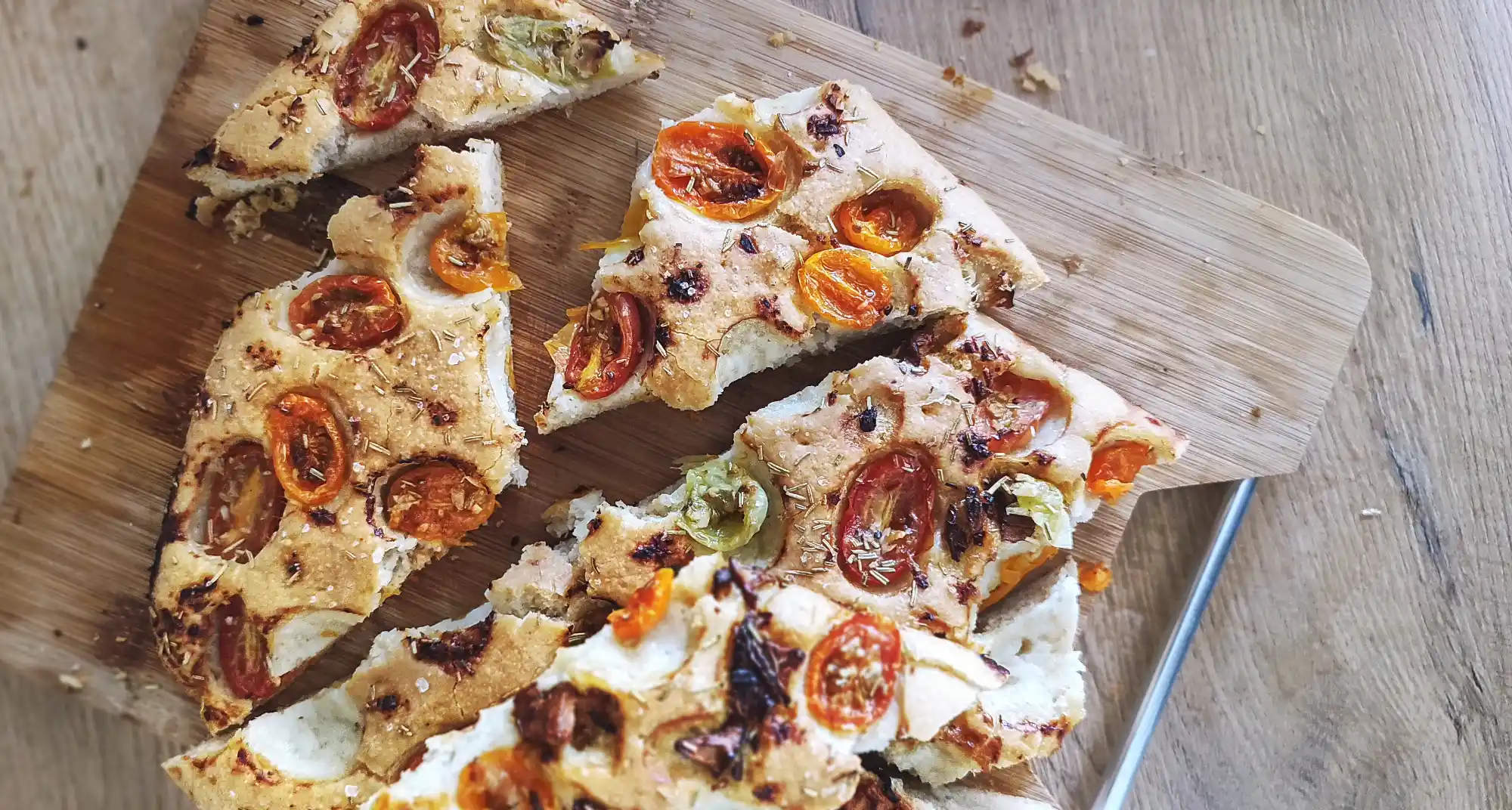In this delicious recipe for Focaccia With Cherry Tomatoes and Rosemary, I’ll show you how to make a wonderfully tasty homemade focaccia bread using spelt flour, generously sprinkled with cherry tomatoes, rosemary, aromatic garlic and savoury grated Parmesan cheese.
The best part? There’s absolutely no kneading required. This no-kneading approach simplifies the process of making homemade focaccia so much that you’ll feel like you’re strolling through the canals of Venice.
Table of Contents
Jump to Recipe
About Foccacia
The secret of great focaccia lies in the balance between simplicity and quality ingredients. What sets focaccia apart is its airy, dimpled texture and the use of generous amounts of olive oil.
Italians love focaccia for its versatility; it can be a snack, a side dish or even a meal when filled with toppings.
Although Italy is famous for focaccia, its roots go back to ancient civilisations around the Mediterranean. To prove my point and do some advertising for my Croatia coast, don’t go out of Croatia if you haven’t tried Komiška Pogača.
And no, pizza dough and focaccia dough aren’t the same; focaccia tends to be softer and uses more oil. So whether you’re in Italy or anywhere else, enjoy the delicious simplicity of focaccia!
Mamma mia! 🙂

How to eat your homemade bubbly focaccia with cherry tomatoes and rosemary?
Enjoy your Foccacia bread with prosciutto, mozzarella, drizzled with more olive oil and served with crisp arugula salad. It can be used just like regular bread, but with a delicious Mediterranean twist that will enhance your dining experience.
For a tasty meal with lots of flavors and textures, try Roasted Broccolli with Pecans from Syrup and Biscuits, as a side, or with Soffritto from The Bella Vita. They go well with warm, bubbly focaccia.
Focaccia With Cherry Tomatoes and Rosemary Recipe
Homemade Focaccia Bread With Cherry Tomatoes and Rosemary Topping
In this delicious recipe for Focaccia With Cherry Tomatoes and Rosemary, I’ll show you how to make a wonderfully tasty homemade focaccia bread using spelt flour, generously sprinkled with cherry tomatoes, rosemary, aromatic garlic and savoury grated Parmesan cheese.
Ingredients
Fresh parsley, finely chopped
3 garlic cloves, thinly sliced
Olive oil (about 1 dcl(1/3 of a cup))
One handful of grated Parmesan cheese
Cherry tomatoes, halved
Fresh rosemary leaves
Directions
- Cut garlic and parsley into small delicate pieces and generously add olive oil. Mix in the grated Parmesan cheese.
- Add halved cherry tomatoes to the garlic, parsley, and olive oil mixture. Leave to rest and marinate for 15 minutes.
- Take out cherry tomatoes one by one and position them evenly over the focaccia dough. Spread the fresh rosemary leaves all over the focaccia. Drizzle the remaining olive oil generously over the focaccia.
- Grind crystals of salt over your homemade focaccia bread with mushrooms.
Recipe Video

Click on the link to get the recipe for the easy, no knead homemade focaccia bread dough.
This recipe lets you skip the kneading. You gently mix everything together, let the dough rise on its own, and boom – no need to knead! So grease up those pans and get excited to make this yummy no-knead focaccia!
FAQ Focaccia With Cherry Tomatoes and Rosemary
What’s the secret to making great focaccia?
Unlike more complex breads, focaccia thrives on a few key elements. First and foremost, quality olive oil is essential; it not only imparts flavour, but also contributes to the coveted tender yet crunchy texture. Secondly, the dough needs time to develop. While this recipes calls for a double rise, even a single, slow rise in the fridge can produce equally delicious results. Finally, don’t be shy about your toppings! Whether you prefer classic rosemary and sea salt or more adventurous choices, toppings are where you can get creative and add your personal touch.
What makes focaccia bread different from other types of bread?
Focaccia stands out in the bread world for its distinctive texture and flavour. Unlike standard bread, focaccia is characterised by its dimpled surface, which creates pockets for the olive oil to collect, resulting in a rich, savoury flavour. Focaccia is also incredibly versatile; it can be enjoyed plain with a drizzle of olive oil and a sprinkling of sea salt, or topped with a variety of ingredients such as herbs, vegetables or even cheese.
Does focaccia dough need to rise twice?
Focaccia dough does not necessarily need to rise twice. A single rise can produce excellent results, especially if a slow overnight rise is used in the refrigerator.
This longer, slower rise allows the dough to develop flavour and texture without the need for a second rise. However, the double rise in focaccia recipes serves several purposes. Firstly, it allows the yeast to ferment, which enhances the flavour, and the first rise relaxes the dough, making it easier to handle.
Secondly, after shaping, the second rise strengthens the gluten structure, making the dough lighter and more airy. This results in the characteristic open crumb and tender, chewy texture of focaccia. In addition, this longer fermentation period contributes to a complex flavour profile. Finally, it can increase digestibility by breaking down complex starches and proteins, which is particularly beneficial for those with mild gluten sensitivities.
If you’re short on time or prefer a quicker process, a single rise at room temperature will work just fine, even without prolonged figerator fermentation. The key is to let the dough rest and rise until it’s about doubled in size, whether it’s a single or double rise, to achieve the perfect focaccia texture.
Should focaccia be thick or thin?
The thickness of focaccia is a matter of personal preference, and both thick and thin varieties have their virtues.
Traditionally, a classic focaccia is often about 2.5 – 4 cm (1 to 1.5 inches) thick, providing a satisfying combination of crisp exterior and soft, airy interior. Experiment with different thicknesses to find your favourite version of this popular bread.
What country is famous for focaccia?
While focaccia is enjoyed in many forms throughout the Mediterranean region, it is particularly famous in Italy. Italians, like many cultures, have a deep love of bread and focaccia holds a special place in their culinary heritage.
Focaccia’s simplicity and versatility make it a popular staple in Italian cuisine. It can be enjoyed as a quick snack, as a side dish or even as a meal when filled with a variety of toppings.Whether it’s the classic rosemary and sea salt version or a more elaborate creation with olives, tomatoes or cheese, focaccia provides a canvas for culinary creativity.Its roots date back to ancient times around the Mediterranean, and today it remains a cherished part of Italian gastronomy, often served in homes and local bakeries throughout the country.
What country invented focaccia bread?
If you’re visiting Croatia, don’t go if you haven’t tried Komisku pogacu 😉
The invention of focaccia bread is attributed to ancient civilisations around the Mediterranean, making it difficult to pinpoint a single country as its origin. It has its roots in regions such as Italy, Greece and the wider Mediterranean, where flatbreads have been made for thousands of years. The word ‘focaccia’ itself comes from the Latin ‘focus’, meaning hearth or place for baking. Over time, different cultures and regions have developed their own variations of focaccia, resulting in the wide range of recipes and flavours we enjoy today.
Are pizza dough and focaccia dough the same?
Pizza dough and focaccia dough share some ingredients: flour, water, yeast and salt. The main differences are in texture and preparation. Focaccia dough is typically more moist and contains more olive oil, giving it a softer, chewier texture and a distinct flavour. Pizza dough, on the other hand, is usually drier and requires less oil, resulting in a crispier crust. While both are derived from basic bread dough, these variations in ingredients and cooking techniques create the unique characteristics that distinguish focaccia from pizza. So while they’re close cousins in the world of bread, each has its own delicious personality.
Popular Turbo Tasty Recipes






